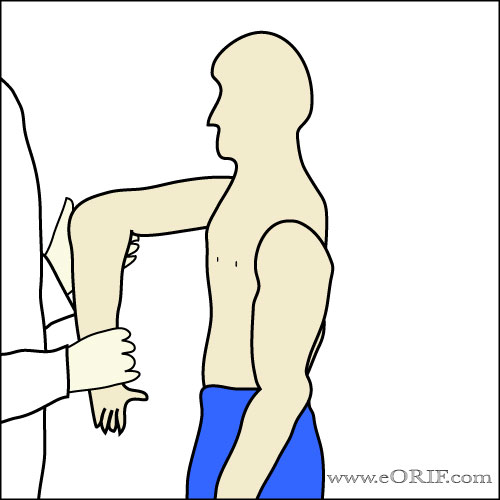 |
synonyms: subcoracoid impingement
Coracoid Impingement ICD-10
- M75.50 - Bursitis of unspecified shoulder
- M75.51 - Bursitis of right shoulder
- M75.52 - Bursitis of left shoulder
- M75.80 - Other shoulder lesions, unspecified shoulder
- M75.81 - Other shoulder lesions, right shoulder
- M75.82 - Other shoulder lesions, left shoulder
Coracoid Impingement ICD-9
Coracoid Impingement Etiology / Epidemiology / Natural History
- Impingement of lesser tuberosity or subscapularis tendon on the coracoid process.
- Uncommon. More often occurs in patients involved in activities which require overhead positioning with internal rotation.
- Reported in tennis players and weightlifters.
- Associated with Subscapularis tears 840.5.
Coracoid Impingement Anatomy
- Lesser tuberosity impinges on the coracoid with flexion and internal rotation.
- Mean width (medial-to-lateral dimension in the plane of the subscapularis tendon) of the coracoid tip is 15.9 mm; mean length of the coracoid tip is 22.7mm. The mean thickness of the coracoid tip at its midportion is 10.4mm. (Lo IK, Arthroscopy 2004;20:591).
- The anteromedial portion of the coracoid tip is closest to the neurovascular structures. The distance from the anteromedial portion of the coracoid tip to the axillary nerve=30.3mm, the musculocutaneous nerve=33.0mm, the lateral cord=28.5mm, and the axillary artery= 36.8mm (Lo IK, Arthroscopy 2004;20:591).
- Distance from the anteromedial aspect of the base of the coracoid to the axillary nerve=29.3mm, the musculocutaneous nerve=36.5mm, the lateral cord=36.6mm, and the axillary artery=42.7mm (Lo IK, Arthroscopy 2004;20:591).
- Distance between the lateral cord and the coracoid tip at 30° of shoulder abduction is 26.6 ± 5.2 mm and 23.4 ± 5.1 mm at 60° of abduction. (Pan WJ, AJSM 2008;36:1998).
- The lesser tuberosity always makes contact with the coracoid process within the normal range of motion of the shoulder. The coracohumeral distance increases with external rotation and decreases with internal rotation. (Radas CB, JSES 2004;13:154).
Coracoid Impingement Clinical Evaluation
- Pain reproduced with shoulder flexion and internal rotation.
- Tenderness in the anteromedial shoulder over the coracoid process.
- Coracoid Impingement Test: pain and clicking with passive forward flexion, adduction and internal rotation (Dines DM, JBJS 1990;72Br:314) (Ferrick MR, AJSM 2000;28:117).
- Local anesthetic injection between the lesser tuberosity and coracoid eliminates symptoms in patients with coracoid impingment.
Coracoid Impingement Xray / Diagnositc Tests
- CT: normal coracohumeral distances in the adducted shoulder = 8.7mm. Flexed shoulder = 6.8mm. <6mm indicates narrowing (Gerber C, CORR 1987;215:132), (Nove-Josserand L, CORR 2005;433:90).
- Coracoid index = drawn on axial CT image. Draw a line tangential to the glenoid face and measure the distance which the coracoid projects beyond the line. Average value = 8.2mm. (Dines DM, JBJS 1990;72Br:314). Value indicating Coracoid impingement has never been determine and the Coracoid index has not been validated.
- MRI: may demonstrate coracoid extending lateral to the GH joint on coronal images, associated subscapularis tear or tendinitis (axial images), or an inferior hook on the coracoid (coronal and sagittal images). MRI done in internal rotation best demonstrates coracoid impingement. Narrowed coracohumeral distance (<6mm) is associated with subscapularis tears. (Richards DP, Arthroscopy 2005;21:1223). Normal coracohumeral interval on MRI with arm in internal rotation = 11mm. Symptomatic shoulders = 5.5mm (Friedman RJ, Orthopedics 1998;21:545).
Coracoid Impingement Classification / Treatment
- Corcoplasty: goal is 7-10mm space between coracoid and humeral head/lesser tuberosity. (Lo IK, Arthroscopy 2003;19:667).
Coracoid Impingement Associated Injuries / Differential Diagnosis
Coracoid Impingement Complications
Coracoid Impingement Follow-up Care
Coracoid Impingement Review References
|

